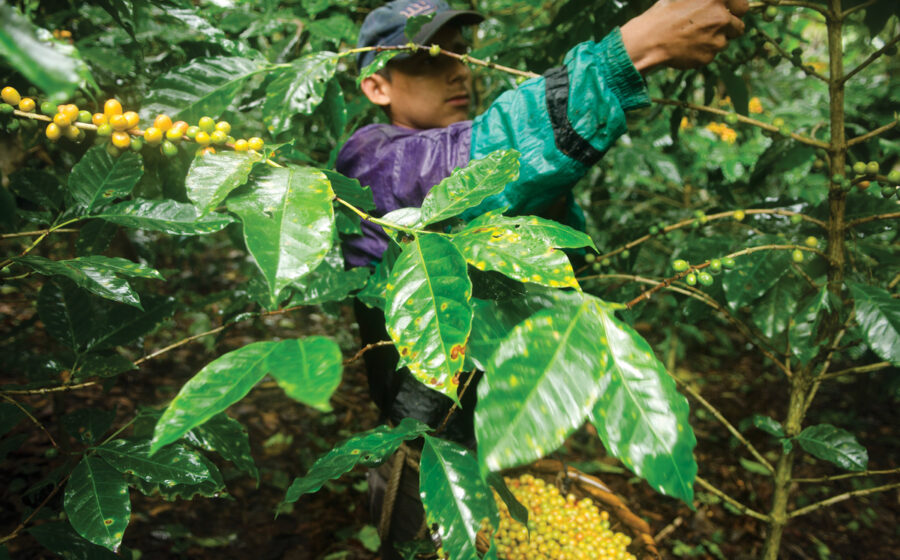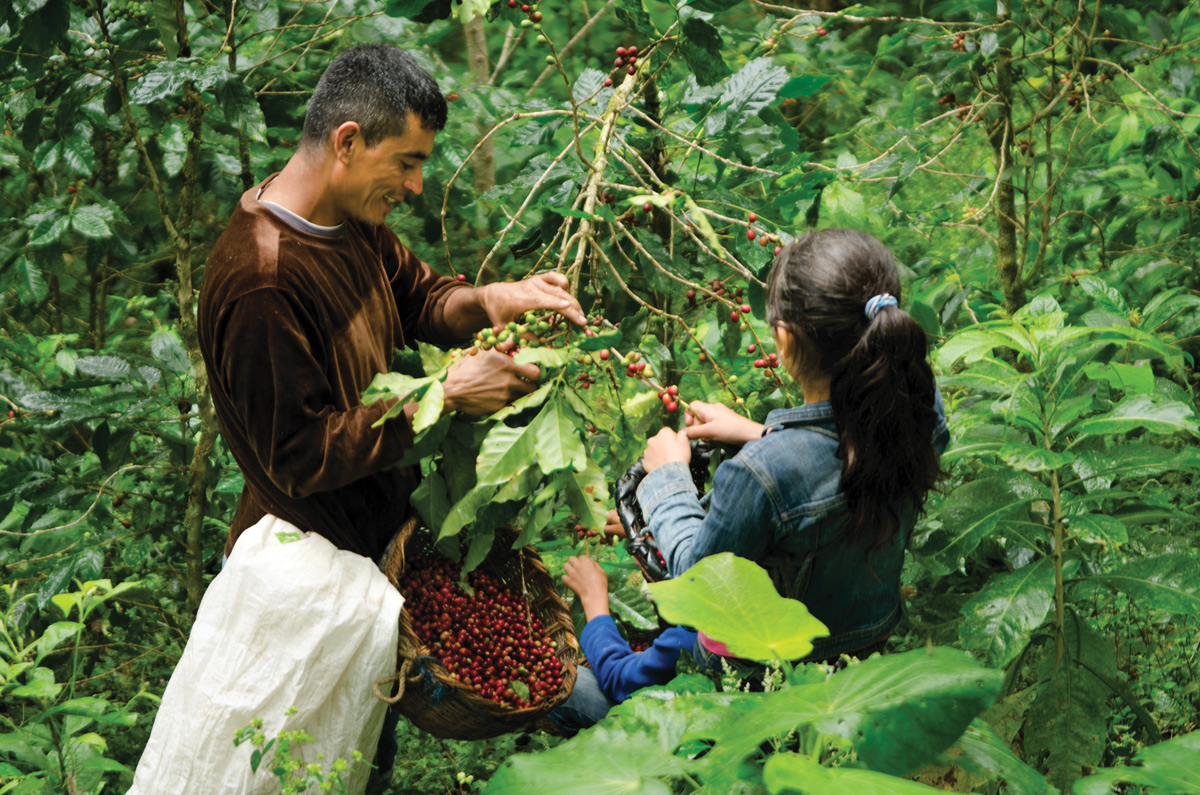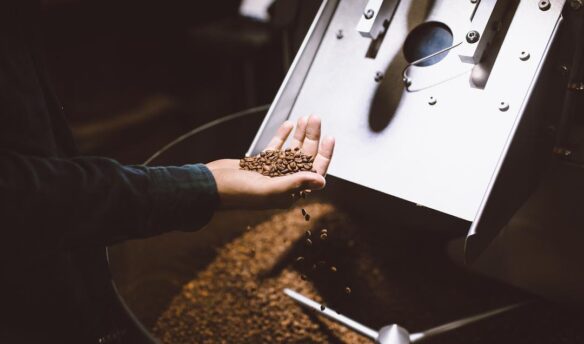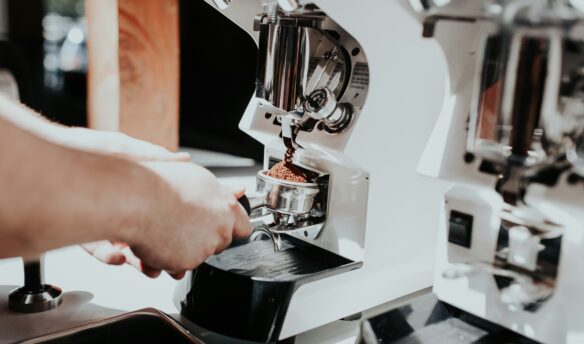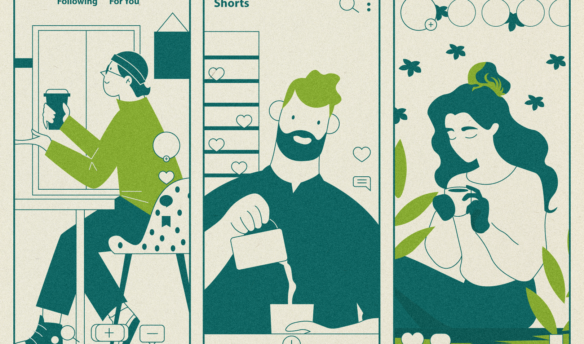[E]l Sontule is a rural coffee-growing village of fewer than 200 people in the northern mountains of Nicaragua inside the Miraflor Nature Reserve, one of seventy-eight reserves in the country protected for its environmental resources and biodiversity. It is fewer than forty miles from Estelí, the nearest city, but the bus ride takes nearly two hours, following a route that winds up steep dirt roads and fords one small river.
I first took that twisty journey to El Sontule in August 2013 in an old American school bus, one of those affectionately called chicken buses by visitors. I had come to learn about coffee rust, known in Latin America as la roya, the fungal epidemic that had by then taken hold in much of coffee-growing Central America and was devouring the crop. I was taking this dirt road to meet the Pérez Villarreyna family, who grow organic Arabica in the shade of forest trees. Their eldest son Uriel, a tour guide working in Estelí, had arranged the meeting. His father, Marvin Pérez, is president of Vicente Talavera, one of El Sontule’s two main coffee cooperatives. The two cooperatives belong to PRODECOOP, a distribution service made of thirty-eight cooperatives that sells roughly half organic and half conventional coffee.
The family lives in a small wooden house. Pérez and his wife, Mefalia Villarreyna, share it with their youngest son, Wilder, who’s twenty-one, and two nephews, fifteen-year-old Jeyson and eleven-year-old Freyder. The house neighbors El Sontule’s evangelical church and is about a ten-minute walk from the community’s elementary and middle schools. The high school is in another community, and the trip there and back takes students a couple hours on horseback.
The Pérez Villarreynas have been working in coffee production for over half a century. Their ancestors were landless peasants, toiling on coffee plantations that bolstered the wealth of absentee owners. But after the Sandinista revolution in 1979, the new government broke up large landholdings and conferred ownership to the people who worked them. During the subsequent US-sponsored Contra War, the residents of El Sontule banded together for unity, to protect their interests, and occasionally to fight. At the time, neighboring Honduras allowed the United States to train and deploy fighters from their country. Since the Miraflor area lies just sixty miles from the border, it was hit hard.
Beaten down from fighting, in 1990 the Nicaraguan people voted out the Sandinista government, hoping to induce the United States to drop their support of the Contra forces and lift its embargo, and stop the violence. The new administration of Violeta Chamorro didn’t support the cooperative system, but the people of El Sontule kept the land they received during the redistribution of the Sandinista years.
In a normal year they would have walked among verdant hills. But this year, the bare plants had discarded their orange spotted leaves, the crumpled remains littering the ground.
Since the years of war, nothing has hit El Sontule harder than rust.
I returned in January of 2014 for the harvest. The month is usually a busy time in El Sontule. Kids are on break from school until mid-February, and families fill the hillside, navigating through coffee trees, picking the red fruit. On the day I joined Jeyson he was helping his uncle Marlon Villarreyna and a couple of cousins harvest Marlon’s crop. His half brother Freyder tagged along to pop the cherries into his mouth, biting through the hard pulp to enjoy the sweet honey-like syrup that coats each coffee bean. The harvest is described with the verb cortar, to cut, but they carried out the entire labor by hand, popping the fruits, one by one, off the trees with their thumbs and pointer fingers, dropping them in handmade woven baskets.
In a normal year they would have walked among verdant hills. But this year, the bare plants had discarded their orange spotted leaves, the crumpled remains littering the ground. Many of the plants had been heavily pruned. Or they had died. The Pérez Villarreynas had cut down the infected plants and replanted new ones, hoping that these, which would take at least three years to reach their first decent harvest, wouldn’t also fall prey to roya. Marvin Pérez used an organic fungicide called Bordeaux mixture, caldo Bordelés, which he applied to his saplings to offer them protection. In the meantime, they were not expecting a very bountiful harvest.
The yield a particular family would gather from this harvest depended a lot on luck. The Pérez Villarreynas had lost over eighty percent of their coffee to rust. On the other hand, some neighbors had lost little. But overall in El Sontule, farmers experienced a forty percent reduction during the 2012–2013 harvest, which paled in comparison to the near ninety percent decrease they saw in the 2013–2014 season. That’s according to Suyen Baharona, program coordinator at the Center for Global Education, which has been organizing educational trips focusing on social justice issues to El Sontule and other parts of Nicaragua for fifteen years.
Scientists are not in agreement about why this epidemic is occurring now in Central America. Many blame climate change, saying that warmer, wetter conditions are allowing the rust to proliferate in places that it could not before. But there are other scientists who believe that modern agricultural practices of pesticide use and deforestation are the culprits, upsetting the ecosystem balances that have kept the rust, which has always existed in small doses in Central America, from blooming out of control.
Although El Sontule is a rural community without a lot of resources, they pride themselves on having high ecological and educational standards. Most of the growers, young and old, are informed and well-versed on environmental issues and have a lot to say when it comes to discussing growing practices and environmental management. If you ask the farmers of El Sontule about the rust, they, like many scientists, believe cambio climático, climate change, is to blame. “There was a time when there was winter, and then after there was summer,” says Marvin Pérez. “Now, it can be raining in the summer. We’ll have times where it’s really hot, and then suddenly, it’s raining.”
In the fields, after the coffee cherries are detached one-by-one from their plants, the shiny red fruits are loaded into big, white sacks and taken to the community’s shared washing and pulping station, either by foot or by horse. The workers manually pulp the cherries and the newly naked beans are returned to their sacks and left to ferment in the sun for a few days. The pulp is left out to do the same, and eventually becomes compost. After it is fermented, the coffee is washed and separated, with the lowest quality beans discarded, the middling tier kept by the farmers, and the best sent to PRODECOOP’s facilities in Palacaguina, a warmer, drier town about an hour from El Sontule.
Before Marvin and I boarded the old school bus to Palacaguina, painted outside with bright colors and covered inside with stickers of Jesus and the Virgin Mary and Wile E. Coyote, he helped his neighbors load their bulging pink sacks of coffee onto the vehicle’s roof. Out in the hot sun in Palacaguina, workers dried the beans on giant, concrete patios, before sorting them for quality, with separate machinery in all stages for the organic and the conventional beans. The coffee beans are then shipped to buyers in the United States, Europe, and Asia.
The second-tier coffee that the Pérez Villarreynas keep goes through a different process once it’s been washed. If there’s sun, it’s left out to dry for three days. During my visit, despite being summer, it had been raining on and off for days, so instead of drying outside, Mefalia dried the beans at home in a large iron pot on their clay oven. The coffee was still covered in a thin parchment, so Marvin, Freyder, and Jeyson carried the beans to a nearby house belonging to Jeyson’s grandfather, where they dumped them into a man-made hole in a rock. Taking a large wooden stick that was leaning against the house, Freyder, Jeyson, and Marvin took turns beating the coffee in the hole, freeing the beans from their parchment. Every once in a while, Jeyson or Marvin would scoop some coffee out of the hole, and drop it back in slowly, letting the wind carry the parchment away. They continued this winnowing until there were no beans with the papery coating. The coffee was now ready to be roasted.
Marvin brought the coffee to a neighbor, Jackson Flores, who roasts the village’s coffee. Freyder followed as fast as he could, laden with an armful of kindling from cut-down coffee plants. Resembling a pig on a spit, Jackson’s roaster has thin iron handles coming out two sides of a big, hollow oval, which he filled with the green beans. The roaster was thick with soot. Jackson began to turn the roasting chamber slowly over the fire. Periodically, he or Marvin would stick a thin iron trier into a small hole in the chamber, extracting a few beans to test color and aroma.
When the coffee reached a deep, chocolate brown, Jackson dumped it onto a mesh screen to cool. The smell of fresh coffee filled the air. Now came the best part, taking the coffee back to the Pérez Villarreyna’s kitchen, grinding the beans by hand, adding the ground beans to a big pot of boiling water to brew, then straining the grounds and pouring the rich, bitter beverage into their red thermos, a ubiquitous presence on their kitchen table, somehow always magically filled with warm coffee. The Pérez Villarreyna’s kitchen is usually filled with friends or family, who stop by to chat and enjoy a cup of their coffee. “We don’t have enough coffee to export right now,” says Pérez, “but we have enough to drink.”
Although the residents of El Sontule still have coffee to drink, and some have enough to export, the rust remains a threat to their ability to stay here. As a Fair Trade member, the Vicente Talavera cooperative receives a $20 premium per quintal (100 pounds) of coffee. They call it a premio social, a social premium they use for renovating their plantations or paying for school fees and supplies. Of course, fewer exports mean less money. “If we don’t have coffee because of roya, we won’t have social projects,” Pérez says.
“We don’t have enough coffee to export right now,” says Pérez, “but we have enough to drink.”
Nearly 400,000 coffee workers across Central America have already lost their jobs because of rust, according to Oxfam and Promecafe, and many have left their homes to move into already crowded cities or tried their luck going to the United States without papers. USAID estimates that rust could end up costing the region an estimated 500,000 workers in the coming years if progress is not made. And while the Pérez Villarreynas have lost much of their coffee, they still have it better than some. Mefalia teaches at the local school and they run a homestay for tourists. The family also has a large garden where they grow food both to eat and sell. Both Uriel and Wilder are currently studying in universities in Estelí.
For my last night in El Sontule, the Pérez Villarreynas bought two chickens from a neighbor and made a big, delicious meal. They invited Mefalia’s mother, Modesta, and Jackson, the local roaster, came by for some red beans and rice. After dinner, we drank Flor de Caña rum and homemade lemonade and listened to a baseball game on the radio.
The glow of the wood fire in the stove along with the lone lightbulb in the kitchen gave warmth to the clay-floored room. Mefalia sat on a chair near the stove, feeding bits of tortilla to the two dogs, Scott and Campeón. I played a card game with Freyder, Jeyson, Jackson, Wilder, and Marvin. At the end of the table was, as always, the red thermos, signaling hot, delicious coffee, ready to be enjoyed. The caffeine doesn’t keep me awake, so I poured myself a cup, black, to counteract the rum.
Hopefully, that thermos will remain there.
—Stephanie Parker
